




Back to the Around WWI calendar



 One of the problems which faced Britain during the war was in getting enough supplies from other countries, mainly food. Being an island, everything had to come by boat in those days. At the beginning of this year Germany stepped up the U-boat campaign. Instructions were given to the U-boat commanders that all allied or neutral ships were to be sunk on sight and in one month almost a million tons of shipping went to the bottom of the sea. Neutral countries didn't want to risk sending goods to Britain and so Lloyd George, the British Prime Minister, ordered that all ships carrying goods for Britain should be given an escort of British warships. However this decision by Germany seemed to backfire as, on April 6 1917, the United States of America declared war on Germany as many of their ships had been attacked and soon American troops and armour would arrive in Europe.
One of the problems which faced Britain during the war was in getting enough supplies from other countries, mainly food. Being an island, everything had to come by boat in those days. At the beginning of this year Germany stepped up the U-boat campaign. Instructions were given to the U-boat commanders that all allied or neutral ships were to be sunk on sight and in one month almost a million tons of shipping went to the bottom of the sea. Neutral countries didn't want to risk sending goods to Britain and so Lloyd George, the British Prime Minister, ordered that all ships carrying goods for Britain should be given an escort of British warships. However this decision by Germany seemed to backfire as, on April 6 1917, the United States of America declared war on Germany as many of their ships had been attacked and soon American troops and armour would arrive in Europe.
And still the fighting in trenches went on. Sometimes one side advanced, sometimes the other. The land which was once Belgium and north-eastern France was now just mud, dead bodies, gun shells and trenches. Once again there was another battle around the town of Ypres and this took place between 31 July and 6 November 1917. British, Canadian, Australian, New Zealand and French forces eventually captured the Passchendaele Ridge, east of the town. This is sometimes known as the Battle of Passchendaele. After all those months of fighting and the deaths of almost half a million men on both sides, the allies advanced a few miles. During the course of the war the town was almost totally destroyed by all the fighting.

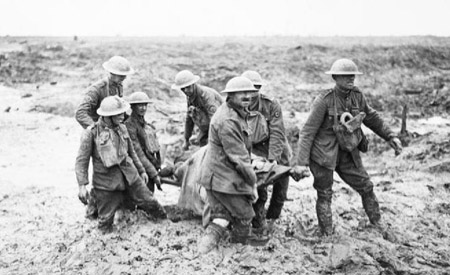
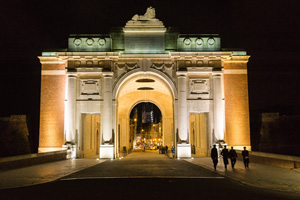 As I said earlier, Ypres had seen some of the heaviest fighting in World War One. By October 1918 nearly 200,000 Commonwealth servicemen had been killed. The town was in ruins. The mayor at the time felt it should not be rebuilt, declaring that it was holy ground.
As I said earlier, Ypres had seen some of the heaviest fighting in World War One. By October 1918 nearly 200,000 Commonwealth servicemen had been killed. The town was in ruins. The mayor at the time felt it should not be rebuilt, declaring that it was holy ground.
However, the town was rebuilt but the Menim Gate was chosen as a place to have a memorial to the lives that had been lost and who had no grave.
The gate contains the names of more than 54,000 soldiers who died in Belgium.
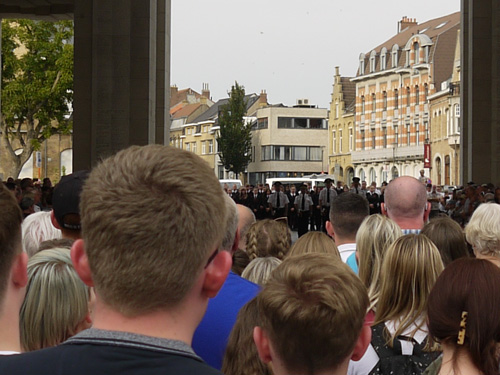 The people of Ypres have another way of remembering the sacrifices made between 1914 and 1918. Every evening since 1928, buglers of the Last Post Association sound the Last Post in the roadway under the Memorial's arches. The ceremony has become part of the daily life of Ypres and traffic is stopped from passing through the memorial each day at this time. Only during the German occupation of the Second World War was the ceremony interrupted. At that time it was held at Brookwood Military Cemetery in Surrey, England.
The people of Ypres have another way of remembering the sacrifices made between 1914 and 1918. Every evening since 1928, buglers of the Last Post Association sound the Last Post in the roadway under the Memorial's arches. The ceremony has become part of the daily life of Ypres and traffic is stopped from passing through the memorial each day at this time. Only during the German occupation of the Second World War was the ceremony interrupted. At that time it was held at Brookwood Military Cemetery in Surrey, England.
In 2019 my son, James, his wife, Rachel, and I went to Belgium for four days and had the privilege of witnessing the ceremony at the Menin gate. We made our way down to the gate ready for the ceremony which begins at 8.00pm precisely. Many other people had gathered and we were somewhat at the back but, by holding my camera way above my head I did manage to get some photos of the ceremony. If my calculations were correct we witnessed the 31,470th time the ceremony had been performed there. It was a very moving moment. This video will let you hear the recording I made live of the Last Post played at the Menim Gate on my 70th birthday, July 17th, 2019. You can also hear the choir sing Abide With Me.
As you listen and watch some scenes of the event, I have added some more pictures from our trip. These include some pictures of the visit Rachel made to a war grave cemetery. One of her ancestors, I think it was a great, great uncle but I may be wrong, had, like so many New Zealanders and Australians, enlisted in their army and come over to Europe to help with the fighting in World War One. Sadly, he had been killed and Rachel wanted to visit the cemetery where he had been buried.
As we drove to the cemetery, called the Trois Arbres Cemetery and actually just over the border in France, we passed a few other small cemeteries all very similar. When you consider that there were 11 million military personnel killed in the war and also 7 million civilians and so much of the fighting took place in this area of France and Belgium, it isn't that surprising there are so many cemeteries. Originally the site of this cemetery was the 2nd Australian casualty clearing station and some burials came from deaths at that hospital. On April 10th 1918 the nearby village of Steenwerck was captured by German forces and the cemetery fell into German hands the following day.
After the Armistice, in November 1918, over 700 graves were brought into the cemetery from the battlefields of Steenwerck, Nieppe, Bailleul and Neuve-Eglise. There are now 1,704 Commonwealth servicemen of the First World War buried or commemorated in this cemetery. 435 of the burials are unidentified but there are special memorials to ten casualties known or believed to be buried among them. Rachel was able to find the headstone of her relation and I left her and James to have a quiet moment with their thoughts. To be killed on a battle field, thousands of miles from home and with little likelihood of your resting place ever being visited by those you left behind was a very poignant thought. I was glad that Rachel was able to, eventually, put right this wrong.
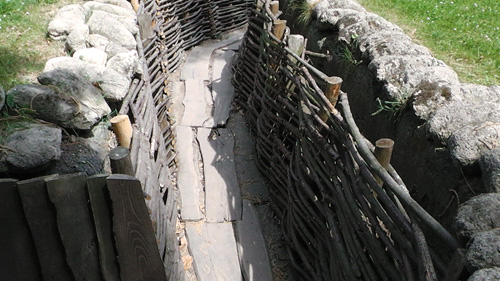 Whilst in Belgium we also made a visit to a place called Bayernwald where they have built a unique reconstruction of a German trench system. This is yet another reminder of this stupid war that killed so many and solved so little. It was initially known as The Great War and called the War to end Wars. It was neither. Great in terms of how many countries became involved, great in the number of lives lost but nothing that kills 18 million members of the human race should ever be called great. As for the war to end all wars, well we already know that 20 years later it all started again.
Whilst in Belgium we also made a visit to a place called Bayernwald where they have built a unique reconstruction of a German trench system. This is yet another reminder of this stupid war that killed so many and solved so little. It was initially known as The Great War and called the War to end Wars. It was neither. Great in terms of how many countries became involved, great in the number of lives lost but nothing that kills 18 million members of the human race should ever be called great. As for the war to end all wars, well we already know that 20 years later it all started again.
The site was opened in 2004. The earliest trenches were, apparently, made of wood and sandbags but by 1916 they looked more like the ones we saw. These had a frame and were connected by wickerwork. During the time we were there, several school parties were also present undertaking various tasks and being given information and having the chance to ask questions.
We then stepped into the trench system and it was here that I felt a certain amount of atmosphere was missing. Don't get me wrong, the Bayernwald trenches are certainly worth a visit. The site is well laid out and the information boards, maps and photos are brilliantly presented. There is much you can find out about the whole area and the thinking behind trench warfare. By walking through the actual trenches you can get a feel for the amount of work that it took to build the trenches in the first place.
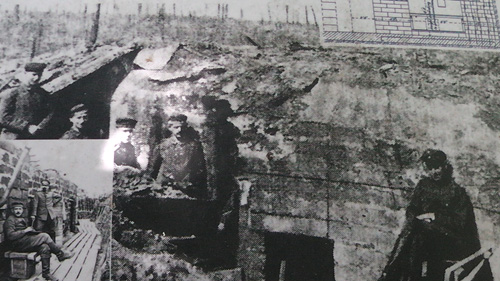 You also come across four of the ten bunkers that were originally on the site. Once again, you can learn from the boards that the bunkers near the front line were made of prefabricated concrete blocks, those further to the rear were just concrete. A walk inside the bunker, too dark to photograph, gave a good idea of the terrible conditions these soldiers lived under and the cramped space which was, essentially their protected homes. The trench system also contains two mineshafts, the biggest of which is 17 metres deep. Sadly I didn't take notes at this point but my understanding is that both the Germans and the British dug these mine shafts and then tunnelled horizontally toward the enemy lines. Something sticks in my memory that the British used Welsh coal miners to dig these tunnels which needed to be boarded up to stop the soft earth collapsing. The objective was that once you thought you had reached the enemy lines, you would place explosives at the end of your tunnel, light the fuses and run away very fast. I think I'm right in saying that explosives were quite unreliable in those days so I'm guessing there were many occasions when the fuse lighters blew up with their explosives.
You also come across four of the ten bunkers that were originally on the site. Once again, you can learn from the boards that the bunkers near the front line were made of prefabricated concrete blocks, those further to the rear were just concrete. A walk inside the bunker, too dark to photograph, gave a good idea of the terrible conditions these soldiers lived under and the cramped space which was, essentially their protected homes. The trench system also contains two mineshafts, the biggest of which is 17 metres deep. Sadly I didn't take notes at this point but my understanding is that both the Germans and the British dug these mine shafts and then tunnelled horizontally toward the enemy lines. Something sticks in my memory that the British used Welsh coal miners to dig these tunnels which needed to be boarded up to stop the soft earth collapsing. The objective was that once you thought you had reached the enemy lines, you would place explosives at the end of your tunnel, light the fuses and run away very fast. I think I'm right in saying that explosives were quite unreliable in those days so I'm guessing there were many occasions when the fuse lighters blew up with their explosives.
I said earlier that despite all the information and the work put in, I felt something was missing. The pictures we have all seen of trench warfare are almost universally pictures of mud and filth. I accept that visiting in mid July under a beautiful Belgian sun could not give this realism. But the other thing missing was sound. Massive guns were constantly blazing out across the landscape, both from behind your own lines and from the enemy lines, sometimes miles away. I took some video footage when I was in one of the trenches and have added, what I feel, is some realistic sound.
When we left Bayernwald, we looked out across the fields toward the city of Ypres and it was then that I truly realised the enormity of this war, on this area of continental Europe. Right in the very distance of this photo you can see some of the spires of churches in the city. The guns stationed here, at Bayernwald, could reach that far with their deadly fire-power. Not only were there three battles of Ypres but the town was almost totally ruined. It was also, as we wrote in 2015, the scene of the first use of poisonous gas as a weapon of war.
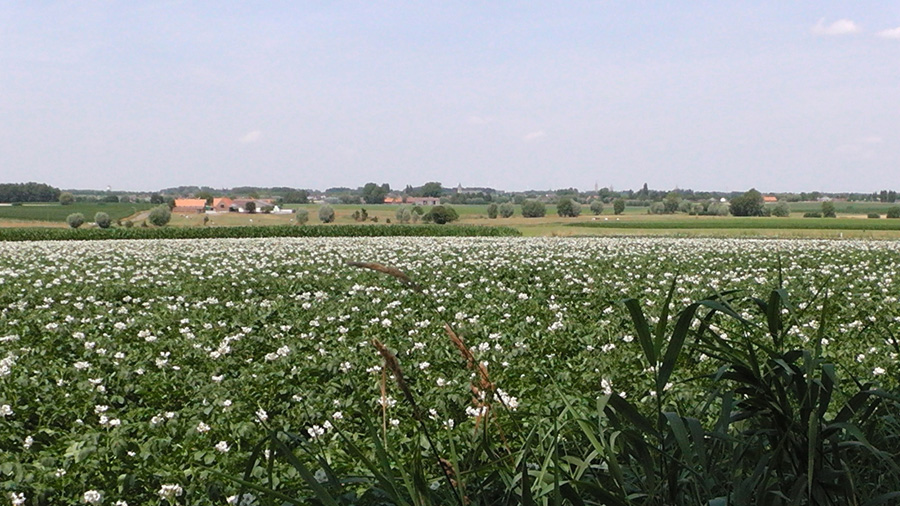
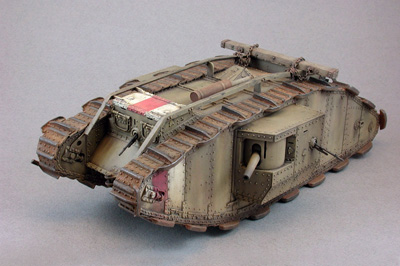 The first battle of World War One between Britain and Germany had involved cavalry and many of the top officers were ex-cavalry men. However, fighting in the mud on horses is useless. The idea of using something like a tractor, able to go over rough surfaces on farms, began to form. In 1915 it was decided that this new motorised vehicle should have the following abilities:-
The first battle of World War One between Britain and Germany had involved cavalry and many of the top officers were ex-cavalry men. However, fighting in the mud on horses is useless. The idea of using something like a tractor, able to go over rough surfaces on farms, began to form. In 1915 it was decided that this new motorised vehicle should have the following abilities:-
- a top speed of 4 mph on flat land
- to turn sharply at top speed
- to climb a 5-feet parapet
- to cross an eight feet gap
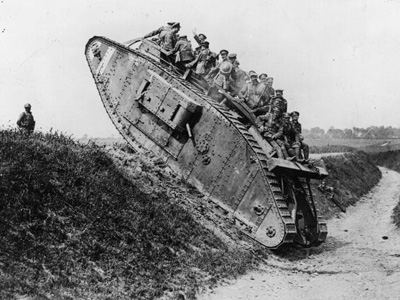 It was also agreed that it would have a crew of ten men with two machine guns on board and one light artillery gun.
It was also agreed that it would have a crew of ten men with two machine guns on board and one light artillery gun.
The first model came off the factory floor on September 8 1915. On September 10, its caterpillar track fell off when the government were watching. The “tank” as it became known as, first appeared during the Battle of the Somme in 1916. On September 15, 36 tanks made a mass attack at the Somme. Originally there had been fifty of these machines but these thirty ton machines could not cope with the harsh lunar landscape of the churned up ground and fourteen had broken down or got bogged down.
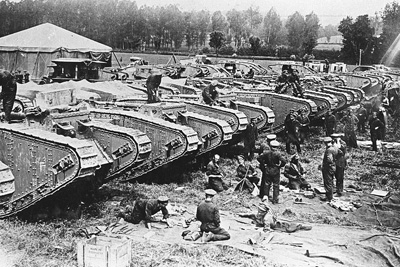 By November 1917 things had improved. The Battle of Cambrai began on November 20 1917. Over 1,000 guns fired at German positions. A total of 476 tanks then attacked German positions along with the usual foot soldiers. The British successfully gained several miles of ground but at the end of the battle had lost about 179 tanks and 44,000 men. The Germans lost 45,000. This is usually viewed as the beginning of a new type of warfare involving armoured vehicles. Tanks had several advantages, the most obvious being that they could just drive straight over barbed wire and the soldiers inside them, operating the guns, were partially protected by the thick bodywork of the tank. The downside was that, being new, they would often break down.
By November 1917 things had improved. The Battle of Cambrai began on November 20 1917. Over 1,000 guns fired at German positions. A total of 476 tanks then attacked German positions along with the usual foot soldiers. The British successfully gained several miles of ground but at the end of the battle had lost about 179 tanks and 44,000 men. The Germans lost 45,000. This is usually viewed as the beginning of a new type of warfare involving armoured vehicles. Tanks had several advantages, the most obvious being that they could just drive straight over barbed wire and the soldiers inside them, operating the guns, were partially protected by the thick bodywork of the tank. The downside was that, being new, they would often break down.
At the end of this year Russia negotiated a deal with Germany and left the war. There had been a revolution in Russia, the royal family had been removed and killed, and the new leaders had neither the time nor the money to continue the war. It was now mainly Britain and France and the newly arrived Americans against Germany and its allies.
Forward to 1918AD

